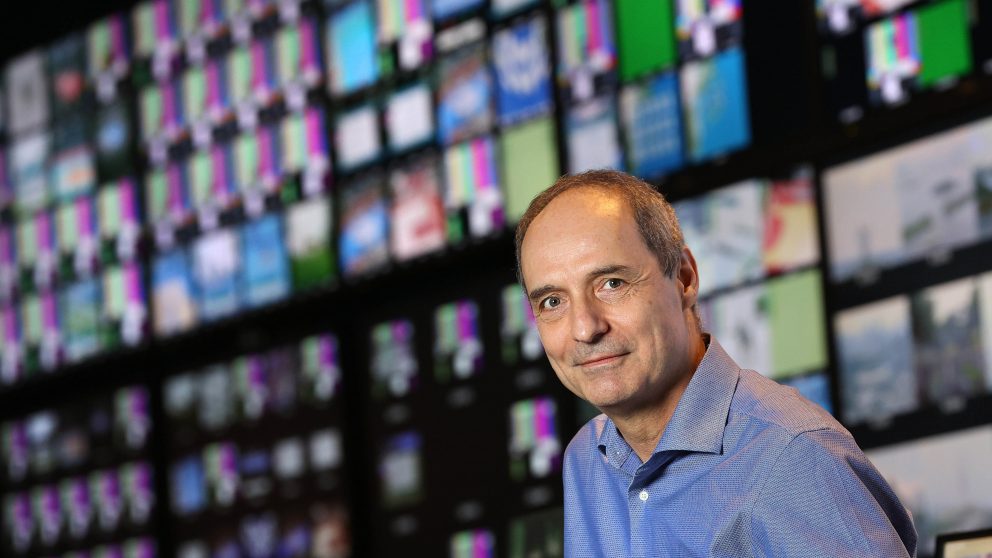
Athlete speaks to her supporters virtually during Tokyo 2020. Photo: ©2021-IOC-All rights reserved Tokyo 2020
Meet the man responsible for making sure the biggest show on earth could go on during the coronavirus pandemic.
Sotiris Salamouris is the chief technology officer of Olympic Broadcasting Services (OBS), the organization responsible for beaming the pictures and sounds of the Olympic Games to billions of viewers’ screens worldwide.
Salamouris oversaw a team of engineers and broadcast technicians that designed and built a platform that made feasible roughly 9,500 hours of footage of the Olympic Games Tokyo 2020. A key element in the success of the event this year was greater use of cloud services, he said.
Alibaba Group’s cloud computing arm, Alibaba Cloud, partnered with OBS to move the backend of broadcasting to the cloud in readiness for Tokyo 2020.
“We look to best tell the story of what happens inside all the sport venues. To do that, we are constantly searching to find the most effective technologies,” said Salamouris during an interview in the International Broadcast Centre (IBC), the media hub for televising Tokyo 2020.
He also talked about overcoming the challenge posed by the postponement of Tokyo 2020 from March last year and which technologies passed the stress test of supporting the world’s largest sporting event and may be deployed at Beijing 2022.
Salamouris is also responsible for OBS’s technical roadmap in the mid- to long-term and the adoption of new technologies.
The following excerpts from the interview have been edited for clarity and brevity
Q: What was the biggest technical advancement at the Olympic Games Tokyo 2020 versus Rio 2016?
Clearly, the explosion in the use of cloud services. The pandemic forced broadcasters to re-evaluate [production] because of the difficulties in reaching venues.
OBS will be producing more than 9,500 hours or so of original content from Tokyo 2020 within two weeks, easily surpassing the total production capacity of a major television station in an entire year.
Rights Holding Broadcasters can access this content from wherever they are in the world, or they can make it available for distributed editing teams. That’s the beauty of the cloud; it is ubiquitous.
We already had very strong feedback that the platform worked very well and met all their needs.



Q: Take us behind the scenes to understand the effort involved in the technical preparations for the Olympic Games?
It’s an enormous project. OBS had more than 8,000 people covering the Olympic Games, creating the videos, audio and gathering the data.
OBS starts planning for the Olympic Games a few years before they take place. We ramp up closer to the actual event, one year before we start building our International Broadcast Centre. We’re talking almost 45,000 square meters of broadcast space that our personnel need to prepare for ourselves but also for all the Rights Holding Broadcasters.
Then getting closer, the number of personnel increases as we start installing technical systems inside the IBC and other venues.
There is a huge amount of human effort involved.
Q: How has the coronavirus pandemic disrupted this process?
Delivering the Olympics is a challenging project under any conditions. The expectations are high: people expect robustness, very high quality, and volume. All the metrics around the Olympic Games are really huge in terms of the number of video feeds and the capacity of networks required.
And lastly, people expect the Olympic Games to be innovative, which can bump up against the requirement of robustness.
New technologies are never available in the volume we need them. Also, they are not that much used as we all expect technologies to prove themselves and to undergo troubleshooting. So we need to manage through conflicting expectations, with high stakes involved.
The pandemic created additional difficulties.
First of all, the delay itself. Postponement sounds nice, one more year [to prepare], but it doesn’t work like that. On the contrary, it created a lot of additional effort for all of us involved in planning Tokyo 2020. When the postponement took place in March 2020, we already had close to 200 people in Tokyo, working to deliver the Olympic Games in August 2020.
We had to freeze the project, take care of our people, and get them home. Let’s not forget, after Tokyo 2020 we are counting down to Beijing 2022. Originally, we had a one-and-a-half-year gap after Tokyo 2020, but because of the postponement, we are left only with essentially a few months before we go to Beijing.
The pandemic has also changed how the world functions, which again affects a major project.
For instance, it has disrupted international transport, goods are checked in a different manner, which impacted transporting all the equipment that we needed to arrive at specific times.
The 8,000 plus OBS people come from 60 plus nations, and they had to fly into Tokyo. Consider all the regimes for testing; it’s really difficult, but somehow, we pulled through.
So, it’s not been easy, but with determination and with a positive spirit, you can do a lot of things.



Q: How did you compensate for not having fans in the seats?
The decision by the Japanese authorities not to allow audiences in the stadiums created a very strange atmosphere. Athletes expect to have people’s support when they are competing.
We love having an audience as they make the overall story around the competition much livelier. It is also an important part of our storytelling to capture the reactions of the people inside the venue.
However, given the circumstances that we fully understand and support, we had to rush and try to figure out alternatives. We created the ‘Virtual Fan’ engagement project where we used technology to bring the reaction of the global audience into the event, creating a kind of feedback loop that could inspire athletes but also make all the people that wanted to travel to Japan and attend the Games feel that they were closer to them.
Viewers were able to contribute by cheering – this created a world map where different countries were illuminated depending on the density of cheering. We also encouraged the audience to upload selfie videos of themselves cheering and supporting their athletes, maybe just a few seconds long, to create a matrix-wall of fans’ videos.
After a competition, athletes had more than 200 short video calls with some family members and friends that were broadcast live. [There were over 250 million cheers from around the world, according to the International Olympic Committee.]
[Alibaba supported virtual engagement by hosting the project on the cloud. Alibaba is a Worldwide Olympic Partner.]
Q: How has technology improved viewers’ understanding of the Olympic Games?
The only way to deliver what was happening was through our technology, including increasing the number of specialized cameras that can capture every single moment, every single angle of what happens.
It’s all about telling the story of the competition, and doing this effectively means placing cameras and microphones as close to the action as possible.
We put sensors on the athletes themselves or on their apparatus to capture different parameters, such as acceleration, speed, height or force. Then we processed the data to make it visually understandable.
We also used artificial intelligence and visual-processing technologies that have the advantage of not interfering at all with the sport.
In collaboration with Intel and Alibaba, we used 3D Athlete Tracking for the first time. It analyzed the 100 and 200-meter races to capture parameters like instantaneous speed or acceleration.
Technological changes also delivered a higher quality. For example, we moved all our production to 4K [resolution], giving more real-life representation of colors and brightness. The picture quality is far closer to reality than it was before. We also delivered these Olympic Games for the first time with fully immersive audio.
Through new technologies, we’re trying to deliver more curated information. This is ongoing as technological capabilities accelerate and content becomes more engaging and richer in transferring reality on the field to viewers’ screens.
Innovation never stops. We already have several things in mind for Beijing 2022
Q: What are the key learnings from Tokyo 2020 for Beijing 2022?
First of all, innovation never stops. We already have several things in mind for Beijing 2022.
A good example is much more extensive use of 5G technology because the environment in Beijing is really very good for that. We are also in the home country of Alibaba, which gives us much more capacity when it comes to processing. It will also mean we will have more ability to pursue several artificial intelligence initiatives.
Our approach is very, very positive when it comes to innovation and the value that it can bring to a big event like the Olympic Games.
To receive the latest news directly in your inbox, sign up for the weekly Alizila newsletter




